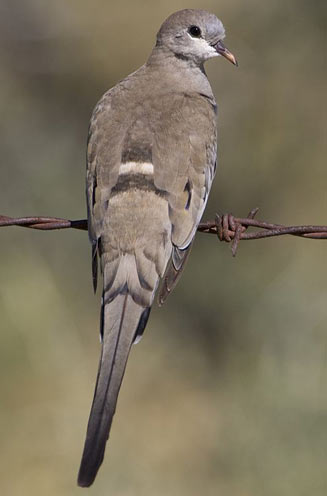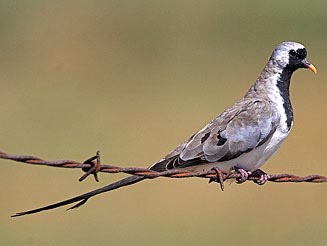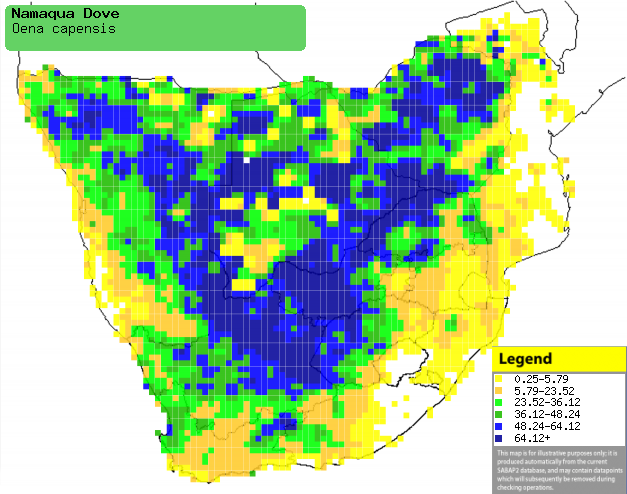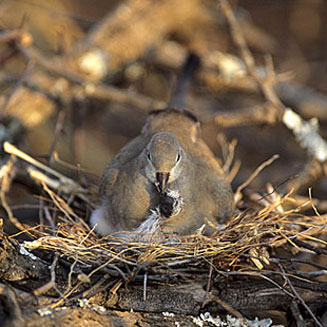|
Oena capensis (Namaqua
dove)
Namakwaduifie [Afrikaans]; Ihotyazana [Xhosa];
isiKhombazane-senkangala, uNkombose [Zulu]; Kambowo [Kwangali]; Mokhoroane,
Mokhorane [South Sotho]; Kanjivamutondo, Nhondoro [Shona]; Xivhambalana (generic
term for dove) [Tsonga]; Mmalommi, Rrankundunyane, Tsêbêru [Tswana];
Maskerduif [Dutch]; Tourtelette masquée [French]; Kaptäubchen [German];
Rola-rabilonga [Portuguese]
Life
> Eukaryotes >
Opisthokonta
> Metazoa (animals) >
Bilateria >
Deuterostomia > Chordata >
Craniata > Vertebrata (vertebrates) > Gnathostomata (jawed
vertebrates) > Teleostomi (teleost fish) > Osteichthyes (bony fish) > Class:
Sarcopterygii (lobe-finned
fish) > Stegocephalia (terrestrial
vertebrates) > Tetrapoda
(four-legged vertebrates) > Reptiliomorpha > Amniota >
Reptilia (reptiles) >
Romeriida > Diapsida > Archosauromorpha > Archosauria >
Dinosauria
(dinosaurs) > Saurischia > Theropoda (bipedal predatory dinosaurs) >
Coelurosauria > Maniraptora >Aves
(birds) > Order: Columbiformes > Family: Columbidae
 |
 |
 |
| Namaqua dove immature male,
Kimberley, South Africa. [photo Trevor Hardaker ©] |
Namaqua dove male (top) and female (bottom). [photo Gerhard Theron
©] |
The Namaqua dove occurs across sub-Saharan Africa, occupying
a wide variety of mostly arid habitats, such as Acacia savanna, arid
shrubland, farmland and rural gardens. It eats almost exclusively seeds, doing
most of its foraging on the ground, especially on gravel or on the edges of
roads. The nest is a fragile saucer made mostly of twigs, usually placed about 1
metre above ground in a shrub, tree sapling or dead dead branch. It lays 1-2
eggs, which are incubated by both sexes, for 13-16 days. In one study, the
chicks were brooded for the first 4-5 days of their lives, and remained in the
nest for 16 days.
Distribution and habitat
Occurs across sub-Saharan Africa, absent
only from the lowland forests of West Africa and the DRC. In southern Africa it
is widespread and common, occurring across Namibia, Botswana, parts of
Mozambique, Zimbabwe and South Africa. It generally prefers Acacia savanna, arid shrublands, agricultural areas,
farmyards, rural gardens and occasionally alien tree stands.
|
 |
|
Distribution of Namaqua dove in southern Africa,
based on statistical smoothing of the records from first SA Bird Atlas
Project (©
Animal Demography unit, University of
Cape Town; smoothing by Birgit Erni and Francesca Little). Colours range
from dark blue (most common) through to yellow (least common).
See here for the latest distribution
from the SABAP2. |
Predators and parasites
Food
Eats almost exclusively seeds, doing most
of its foraging on the ground, especially on gravel or on the edges of roads.
The following food items have been recorded in its diet:
- Seeds
- Amaranthus (pigweed)
- Aridaria (donkievygies)
- Chenopodium mucronatum (Misbredie)
Breeding
- Both sexes build the nest, which is fragile saucer made of rootlets, twigs
and petioles, with the inside lined with grass and rootlets. It is typically placed
about one metre above ground in an Acacia sapling, shrub, dead
branch or occasionally a grass tuft.
 |
|
|
Namaqua dove female feeding its chick, Sericea
farm, South Africa. [photo Warwick Tarboton ©] |
|
- Egg-laying season is year-round, peaking from about
July-December.
- It lays 1-2 eggs, which are incubated by both sexes for 13-16 days.
- In one study, the chicks were brooded for the first 4-5 days of their
lives, remaining in the nest for 16 days.
Threats
Not threatened, in fact widespread and common.
References
-
Hockey PAR, Dean WRJ and Ryan PG 2005. Roberts
- Birds of southern Africa, VIIth ed. The Trustees of the John Voelcker
Bird Book Fund, Cape Town.
|
